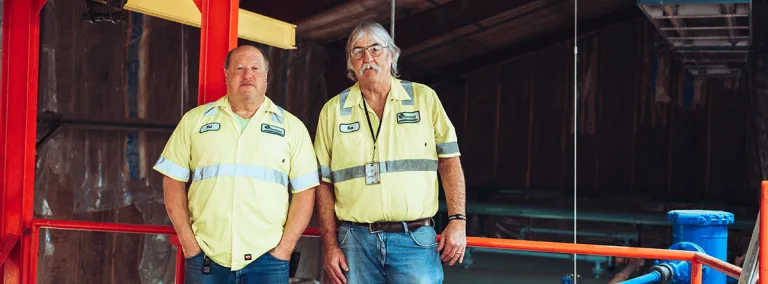Making a splash: SURF surpasses 9 billion gallons of water treated
SURF’s Wastewater Treatment Plant treats water from underground and Grizzly Gulch, safely discharging it into Gold Run Creek
In February, the Sanford Underground Research Facility (SURF) surpassed a new milestone: treating more than 9 billion gallons of water at the Wastewater Treatment Plant (WWTP) since 2008.
“That’s the same as 13,686 Olympic swimming pools — or, you could think of it as one Olympic swimming pool being filled every eight hours since 2008,” said Ken Noren, foreman of the WWTP.
The WWTP was originally commissioned in 1980s to remove the contaminants, including cyanide and ammonia, that were introduced by Homestake’s gold extraction process. The plant introduced patented technology that used native Black Hills organisms to consume cyanide and ammonia, effectively eliminating the contaminants with the first-of-its-kind biological process.
Today, SURF treats water from two sources — groundwater pumped from the underground and overflow from Grizzly Gulch, a reservoir with remaining tailings from Homestake operations. The water passes through two filtration systems and one biological system that together remove suspended solids and other impurities (like iron and ammonia from the Grizzly Gulch tailings).
SURF began tracking the number of gallons treated in June 2008, when the facility began dewatering the then-flooded underground. Noren joined SURF that same month.
Noren and his team haven’t just been maintaining the plant; they consistently reexamine and modify their systems to make the facility more efficient and sustainable. Their modifications allow them to use fewer rotating biological contactors, less power and fewer chemicals in the treatment process, while treating the same volume of water. They’ve also automated the control systems and can run the plant remotely.
The team recently implemented a “gravity flow” system. By modifying the plant’s piping and layout, the team leveraged the gravitational pressure of a reservoir to push water through the plant’s filtration systems. “We used to run three pumps 24 hours per day. Now, we only use three minutes of power each day to backwash the filters,” Noren said.
This change alone will reduce the plant’s energy consumption by approximately 500,000 kilowatt-hours per year, according to Timm Comer, SURF environmental manager.
Once treated, the water is released into Gold Run Creek, which cascades downhill, creating a waterfall-like attraction along Highway 85 between Deadwood and Lead. The water then joins Whitewood Creek within a few hundred yards of the discharge pipe.
SURF regularly monitors the health of these waterways, counting fish and macro invertebrate populations and testing for contaminants. Each year since 2008, the WWTP has been recognized by the South Dakota Department of Agriculture and Natural Resources (DANR) with the Operation and Maintenance Wastewater Treatment Award. This award recognizes “outstanding operation of the wastewater system and environmental compliance with its state surface water discharge permit.”
For nearly 15 years, the WWTP team has processed billions of gallons of water while holding the system to the highest industry and environmental standards.
Reflecting on the accomplishment, Noren said, “It is just hard to imagine that much water being pumped and processed, with most of it being discharged so that others can use and enjoy it.”
